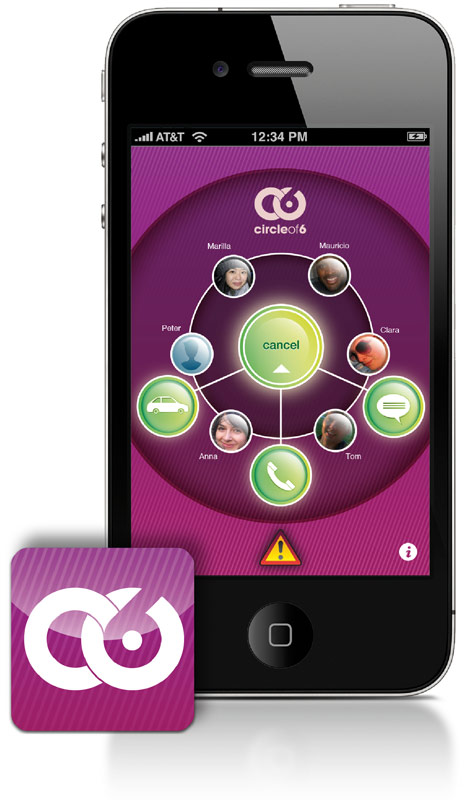 Update: March 7, 2013 It’s official! The President Signed VAWA!
Update: March 7, 2013 It’s official! The President Signed VAWA!
Feb. 28, 2013 Finally! The Violence Against Women Act has passed both the House and the Senate and is moving on for final signing by the President. To celebrate, you’ll love this pop culture Taylor Swift style video send-up about the 22 who voted against VAWA. It’s hilarious. Even though VAWA is no laughing matter!
Feb. 27, 2013 As Teen Dating Violence Awareness Month winds down, and new apps educating and mythbusting about relationship violence ramp up (newest one being the One Love Foundation in partnership with Johns Hopkins University in honor of La Crosse player Yeardley Love) it seems timely to circle back and reframe violence prevention apps and techno tools not as “personal security and safety devices” but rather as mobile methods to engage critical thinking.
It’s promising to see progress veering away from button-pushing toward culture-shifting with new levels of intolerance emerging for abusive behaviors.
The Circle of 6 app and toolkit ask youth to choose six friends to form a circle of trust surrounding dating matters and rely on them to ‘have your back.’
It may even be the first ever mobile support group translating the friends and family dynamic of nurturing comfort into a breakthrough preventive influence.
By engaging people at a deeper level of commitment as both a sounding board and upstander over bystander, it’s proactively deterring isolation and risk to move toward collective action and care.
Sounds like some other support groups uniting around a topic for intervention, doesn’t it? Yep, there’s precedent as to why this formula of peer outreach works…
As a parent to a teen preparing to go off to college, I set off like a Goldilocks reporter to find campus safety apps and dating violence conversations that were “juuuuuuust right”…
…Not too fear-based and bleak with big bad wolf inevitability…
…Not too hyper-vigilant in preparedness with iconic ‘threats’ flagged from police blotter break-ins and city sex offender maps…
…Not necessarily a GPS play by play of revealing exact locales (which could flip from savior to stalker fast in the wrong hands)…
…And certainly not crisis-driven tech reliance instilling a false sense of security where kids wait too long to act until they’re stranded in compromising positions, then depend on the cavalry to come with urgency at the push of a button.
In my hunt for the right serving of safety, tonality and techno porridge it will come as no surprise that the real story is about critical thinking skills, actively empowering youth with these tools to think from the inside out—through their own unique lens, customized and adjusted by age, race, gender, socioeconomics region and cultural interpretations.
What’s the line between someone being creepy and someone making you feel unsafe?
What can you say (and what should you avoid saying) if a friend is concerned about a relationship that seems ‘off?’
How can I tell what’s drama and what’s danger?
These are just a few of the springboards for substantive student conversation; straight from the Circle of 6 Toolkit which was co-written by Melissa Campbell, a sharp, quick-witted young woman I heard speak on stage at Spark Summit awhile back (more of her writing for Spark Summit here).
Rather than launch into a roundup of best apps, features and findings (partial list here and more at the end) my focus today is on the youth-friendly nomenclature and deeper reasoning behind the Circle of 6 app to define what it is and what it isn’t…
There are myriad opportunities for culture-shifting from ‘me to we’ applying the Circle of 6 concept (“it takes a village” approach to humankind) and vast potential for Circle of 6 line extensions and repurposing via mobile for education and outreach/prevention on topics BEYOND dating violence…
I could see uses ranging from messy divorce custody situations (child safety/after school pickups and proactive circles to curb kids being tugged like Gumby) to substance abuse or mental health outreach (a trusted circle educated and willing to step up on a given topic makes a lot of sense in these realms)
Who doesn’t need a ‘trust group,’ honestly?
The critical thinking and self-guided introspection that Circle of 6 can prompt in youth is scratching at the door of a larger conversation about knowledge acquisition, a powerful sense of self and how we choose to walk through the world recalibrating intuition and gut checks along the way.
Who’s got your back? Who’s in your Circle of 6?
What it is and what it isn’t:
A Circle of 6 Primer
Circle of 6 is NOT:
Circle of 6 is NOT a crisis/response tool. Nor is it a “free app that prevents violence before it happens.”
That tagline is a bit misleading and falls into the category of what we in the branding business used to call ‘oversell’ (saying you can prevent violence, is like saying you can prevent rape, it sets the user up for self-blame/shame)
The app is not heavy-handed with visuals of nearby threats, shields, and countdown clocks that conjure visions of Kiefer Sutherland in 24…nor is it packed with scary stats and data on physical, emotional or verbal abuse.
The app is also not an alternative backchannel to 911 (even though some may use it that way in cities where 911 triage is spotty) nor is it ever a replacement for calling the police on campus or off.
I’ll add my personal bias: As a former college off-campus security cop myself, (pre-mobile days, only female on the force working graveyard shift) I can say that relying on ANY ‘gear’ is NOT the way to go. Period. As much as I love purposeful media with solutions-based thinking, I’ll say straight out that I’m circumspect about ANY tech reliance as a safety tool, whether it’s relying on maps to find your way out of a forest for 6th grade “outdoor ed,” or hoping the Fight Back app in New Delhi will shepherd you through dimly lit streets in a country with abysmal infrastructure and enforcement of deterring violence against women.
Yes, gear is your friend, but ultimately, friends are your gear.
(Hmn…There’s a seed of a tagline sprouting folks; part of why I like the Circle of 6 concept for cycle-breaking, culture-shifting and preventive use as it circles back to human interaction, adding value beyond gadgets and gizmos)
Circle of 6 is ultimately a critical thinking app and a conversation starter.
It empowers youth to start asking questions about healthy relationships in a very low key way by exuding a vibe of sophisticated calm. Translation? Teens might even use it.
The simple, easy, well-designed app enables you to summon 6 friends simultaneously and tell them you may need an interruption call or help getting home.
The action icons are exceedingly subtle, discreet and common (a car, a chat bubble, a phone) which anyone who has ever been in an uncomfy scenario can attest is purposefully protective for preventing escalation. The wordless demo showing how it works is equally sleek in its “less is more” message, as they set it to rhythmic music to keep it cross-culturally relevant with no language barriers.
The educational toolkit is separate altogether to keep from cluttering the app, but a handful of key resources like Love is Respect are launchable directly within the app for advice. There’s a button to give friends a heads up that this is a topic you’re exploring further and would like to circle back to get their input on too; again that dialog starter/’ignite’ switch.
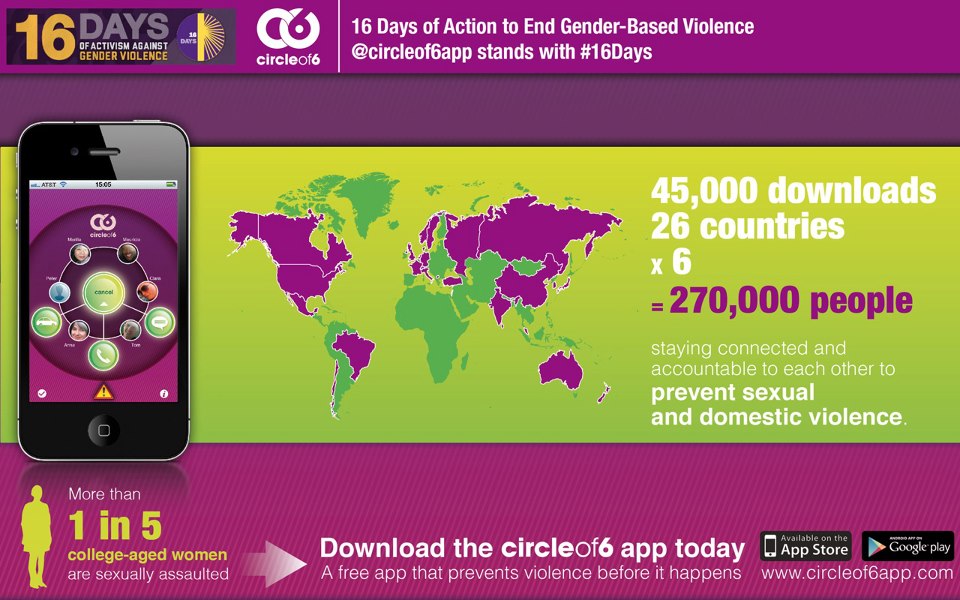 Circle of 6: Empowerment vs Protectionism
Circle of 6: Empowerment vs Protectionism
The Circle of 6 app creators clearly know their audience well…which helps parents like me negate the “geez, give me some credit, I’m not that naïve,” natural pushback that is so common and developmentally apropos.
Youth can whiff angst a long way off on touchy topics, yielding what I call in my household “the dismissive eyeroll of invincibility,” which is teen speak for ‘hey, mom, this is more about you than me,” so I’m extra thankful for the time they spent getting the tone right.
Empowerment vs protectionism is an ongoing hotspot with me, as it floats right under the surface of some existential choices about self-perception and victimhood and it’s imperative parents ‘get this’ before youth tune out to the important conversations embedded within. So how does Circle of 6 hit the right note in the toolkit’s youth-friendly talking points? Beyond being an HHS Apps Against Abuse Challenge winner, I asked Circle of 6 team member Nancy Schwartzman why their visibility is so strong in a sea of apps yet discovered:
“We designed it to meet young people where they are…Rather than be fear-based, we wanted a judgment-free way for friends to become like family when they’re away at school. Most victims of teen dating violence don’t report it, and if they do are more likely to tell a peer than an adult, so we set it up for friends to be the first responders, with a softer nomenclature of peace over violence.”
“We purposely made the user interface social and pretty and kept the toolkit for youth educators easy to relate to because teens understand dating violence differently and define it differently too…We gave specific language about what does and doesn’t help in supporting each other rather than framing in absolutes and we’re inclusive; it’s not about one gender.
As for knowing the space, yes, absolutely, there’s a deep passion there based on personal history from the Line Campaign and my work as a filmmaker (Where is Your Line.org) …The female engineer on the app has direct experience with stalking and I’ve spent a decade out in the field with youth talking about boundary issues around dating and sexual health…so it’s not like we just decided to create an app or win a contest, this is our life’s work.”
—Circle of 6’s Nancy Schwartzman, Founder, Exec. Dir. of The Line Campaign)
Example of youth-friendly verbiage/helpful tonality from the Circle of 6 toolkit for peer to peer interaction (co-written by Melissa Campbell + Nancy Schwartzman)
HERE ARE THINGS THAT DON’T HELP
False assurance. Never encourage a friend to accept violence in a relationship as “no big deal.” If your friend is coming to you with something, listen to her/him –if s/he thinks it’s a problem, you should too.
Ultimatums. It can be frustrating and painful to see someone you love stay with someone who is hurting them, but saying things like “if you don’t break up with this person, we can’t be friends anymore” plays directly into abusers’ hands. Abusers get their power from isolating their victims, so the most important thing you can do is stay close with your friends.
Rudeness or “tough love.” Saying things like “you’re dumb/stupid/silly for staying with this person” or “this person is so bad for you” contributes to isolation. If your friend feels ashamed, s/he will not confide in you.
Being a martyr. Don’t physically intervene when you see violence, and don’t try to carry out “revenge” in the form of violence or harassment.
Insincerity. Don’t laugh at a friend who comes to you with a problem in her/his relationship, and don’t accuse her/him of lying. Try your best to believe what they are saying is true, because things could become serious very quickly.
HERE’S WHAT DOES HELP
Talk to your friend about your concerns in her/his relationship. Don’t be accusatory or rude (“You’re stupid for staying with this person, they treat you like crap”) or set up an ultimatum (“it’s him or me.”). Instead, try something like, “hey, I noticed that your boyfriend/girlfriend/partner is being kind of weird, is there anything you want to talk about?”
Know your adult allies at school or on campus. Who do you trust? Who are the teachers or coaches you can talk to about this? It doesn’t have to be the guidance counselor or the nurse –it can be anyone who makes you feel safe.
Knowing resources: Where can your friend go if she/he wants to report the abuse? Offer to go with her/him: “Do you want to talk to someone together? I can go with you to the nurse or to talk to your aunt/mom/sister/cousin if you want.”
Always being there to listen. Again, abusers get their power from separating their victims from friends, and it’s very important that you make yourself known as a “safe” person that your friend can always count on. Say things like “I’m your friend no matter what” or “I’ll always be here for you,” and mean it.
If you see violence, tell a trusted adult. This can be anyone: parents, teachers, counselors. Stay with your friend to give support. If you see violence in the moment, run and find a trusted adult to intervene. Do not intervene yourself!
Circle of 6: Open critical thinking conversations
…Color outside the lines
Circle of 6 differs considerably from the whole ‘safety and security’ positioning of apps like OnWatch, Guardly,Life 360, Bsafe,Campus Sentinel and other niche focused violence prevention and campus safety apps, and for me as a parent and media literacy advocate, the critical thinking skill sets are what give this app a different focal point and value.
(Check them ALL out, for your own Goldilocks media moment on GPS features; I like them for different reasons; see feature on Life 360’s Family Locator app: part one and part two/teen testing for example)
If you ask a random group of teens what comes to mind when you say “dating violence” most answers will skew toward physical assault ranging from rape to Rihanna. But what about verbal and emotional abuse? And men who are berated and battered? These are jump-starts for important conversations that start to emerge from ‘circles of trust’ and they’re vital in prevention because it nudges toward the blurry spaces and starts myth-shattering early on.
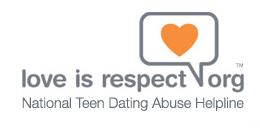 Resources like Circle of 6, Love is Respect,Love is Not Abuse,The Respect Institute and more, spread the media canvas open wide and welcome youth to paint with a large, bold brush, defining and aligning themselves with resources and critical thinking that color outside the lines, asking fresh new questions about roles and rules.
Resources like Circle of 6, Love is Respect,Love is Not Abuse,The Respect Institute and more, spread the media canvas open wide and welcome youth to paint with a large, bold brush, defining and aligning themselves with resources and critical thinking that color outside the lines, asking fresh new questions about roles and rules.
Example from this past week?
The Healthy Masculinity Action Project report at the Verizon Dating Violence Prevention (DVP) Summit connects the dots between the harmful expectations and stereotypes our society teaches boys about what it means to be a man and a national grassroots eradication of this mentality to reverse the course and shift the track on what feels like a runaway train.
This is positive progress! As so many activists have voiced, it’s time to dig deeper into the roots of the problem, rather than top cut the lawn, because the focus should be on removing the culture of violence rather than curbing exposure to it.
Deb Levine of Circle of 6 echoes this hopeful stance toward cycle-breaking and solutions-based outcomes,
“Circle of 6 is THE ONLY prevention tool out there today for dating violence and sexual assault. To date, there has been a lot of important work done towards helping survivors and their families…but what’s different about Circle of 6 from all the other safety apps out there is that it is to be used before a situation escalates.
“It’s not good enough to be dealing with survivors and aftermath and rape panels and awareness raising, we’re seeing an intolerance of behavior bubble up with accountability that create a culture of care… Just using even figures to illustrate…imagine 600 downloads on a campus; each with 6 circles of friends, that’s 3,600 people right there…the campus conversation is changing fast…Indiana University is a great example underway, even the Dean’s office is onboard in trust circles; when students, administrators and faculty all actively convey the message “I support you” and take action to back it up, that’s a powerful statement about school climate.
 Yes, it is. Having a responsive school environment takes the support group of pals in your pocket to a new level of exhale. Feeling safe and confirming that you matter is huge.
Yes, it is. Having a responsive school environment takes the support group of pals in your pocket to a new level of exhale. Feeling safe and confirming that you matter is huge.
I really like the open-ended conversations around dating violence starting to happen too; it’s like a door is left ajar so youth can kick it open wider when they need to, rather than leave teens grappling alone in isolation when something feels not quite right, or second guessing relationship context or even situational awareness…
Finally, using media literacy to decode messaging from music to film that positions controlling and stalking behavior as ‘romantic’ and ‘caring’ versus creepy helps teens connect the dots on why so many mixed messages are ending up sidewinders…It helps explain the ‘whys’ and understand how fast misinterpretation can escalate ‘drama to danger’ while Circle of 6 gives kids the tools and context to start talking about it in a language that helps instead of hinders.
As for scenario planning, using media as a jumping off point to impart public health issues, and asking about where Circle of 6 is headed in the future for Deb Levine added,
“I think it was the Good Wife TV show that embedded a storyline about sexual assault into the script where a buddy system was in play with the use of an app to alert for danger, but then the character was passed out or something and unable to respond…it’s important to factor that in; using media to deliver the message made it even stronger. When you have a circle of six friends, it increases the odds that someone’s bound to be home to respond (again, it’s not a friendship issue, but a proximity/reliability choice) …overall, it’s still about instilling value systems of respect and making note of the power of peer influencers…”
“As for what’s next, I’d have to say more research…How do you even measure prevention? This is the kind of follow-up we’ll be doing next…We’re looking at intent versus impact, and we’ll do a self-reporting survey to see how people are actually using the tools, is it big circles making smaller circles, what are user’s main intentions?
We’ll see what’s working and how to scale and replicate it…I also think we’ll see more campuses like IU dedicated to changing the dialog and shifting to accountability and a culture of care…exciting.
I really think Circle of 6 is more than an app, it is a grassroots movement, where people say, “I will not tolerate sexual violence in my community.” There’s a companion Facebook page with over 5,000 pledgers…Circle of 6 is really an autonomous feminist movement, and with 50,000 downloads and counting, it has the potential to change US college culture in deeper ways, such that University and college students, staff and faculty no longer tolerate this behavior on our campuses. ”
–Circle of 6’s Deb Levine, Founder/Exec. Dir. ISIS
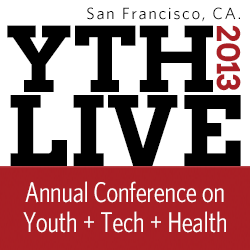 As Tiffany Shlain of the film “Connected” might say, “Let it Ripple”
As Tiffany Shlain of the film “Connected” might say, “Let it Ripple”
Who’s in your circle of 6?
What other ways have you seen media help move the needle toward positive change and cyclebreaking?
For more ways to follow the emergence of mobile health as a game changer beyond dating violence prevention and building healthy relationships, check out the upcoming YTHLive annual conference on youth, health and tech April 7-9 in San Francisco.
Circle of 6 will no doubt have a presence there at the crossroads of conversations about youth, boundaries and consent and college campus life. Join me? The YthLive 2013 program looks like it’s going to be a great one (again!) I’ll be writing more about it soon…
Excellent Resources For Teen Dating Abuse Prevention
Teen Dating Violence Awareness Month: Research/Facts
10 Things Men Can Do About Gender Violence: Jackson Katz
Love Is Not Abuse (List of Partner Links)
CDC Violence Prevention Homepage
CDC Violence Prevention PDF Download
A Thin Line.org-MTV’s Over the Line (digital abuse/teen control)
National Coalition Against Domestic Violence
See It and Stop It! Organization
LiveStrong: Teen Dating Violence
Love is Not Abuse.com (Liz Claiborne campaign)
APA: Teens/Love Doesn’t Have to Hurt (pdf)
HelpGuide.org: Cycle of abuse/DV; cause-effect
HSUS/Animal abuse & corollary w/domestic violence
Center for Relationship Abuse Awareness
Related Reading by Amy Jussel on Shaping Youth
Victim Blaming, “Asking For It” And Baiting Outrage on the Radio
Love is Respect: Teen Texting Tools to Get Dialed In To Dating Abuse
The Bro Code: Media, Masculinity & Misogynistic Misfires
Public Health and the Grammys: Rihanna/Chris Brown DV Messaging
Media Messaging, Binge Drinking and Teens
Depravity Gone Viral: A Thin Line For Humanity
Man Down? Girl Up, Rihanna. Own Your Influence.
What Does A 13-Year Old Boy Know About Dating Violence? Plenty.
Backdraft: DV=Differing Views on Dating/Domestic Violence
Attention KMart Shoppers, Dating Violence on Aisle 3
Predatory Practices As Sport? Boys to Men & Swaggerfests
Gender, Race & Sexism: Shaping Youth Through Pop Culture Cues
Talk to Me: Because Media Matters for Youth Outreach
Uplifting, Positive Picks for Youth Outreach: Resource Roundup
Dear Media, Please Change Your Channel of Influence
Teaching Moments: Get Boys to Participate in “GirlCaught” to Dial Down Disrespect
Girls As Boy Toys Takes an Even More Toxic Turn
Visual Credit for Heart/crayon via PurposefulWoman.com
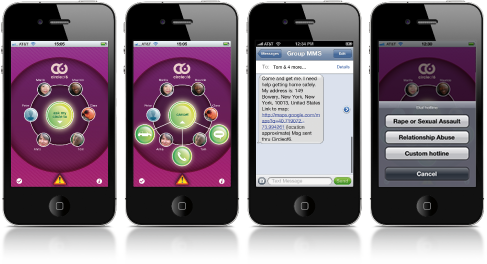









Mobile computing is quickly becoming involved in nearly every aspect of our lives. How we find directions, how we pay for goods, how we get our news, how we socially interconnect with others, and also as a verification of who we are, and nowhere is this more evident than in today’s high-tech colleges. Students and faculty are both using mobile smart phone and mobile computing applications around campus.
They serve as virtual credit cards, and identification for getting into dorm rooms, cafeterias, and secured areas on campus. These are both safety features, and convenience factors. Also, businesses that cater to college students can use such virtual ID systems to allow the students to get into concerts, exhibits, and sporting events – sometimes free of charge, and other times their virtual ID system will bill their college account.